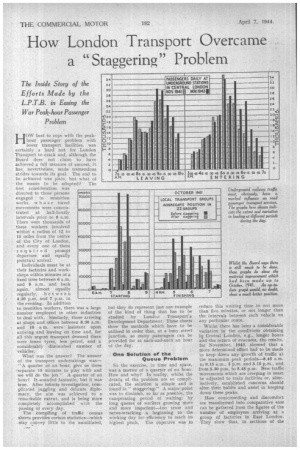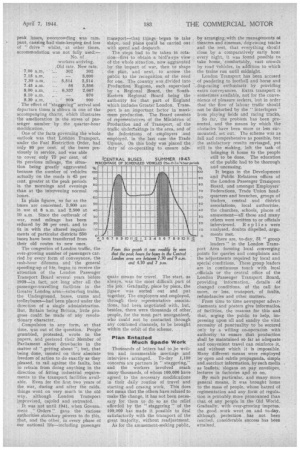How London Transport Overcame a "Staggering" Problem
Page 34

Page 35

If you've noticed an error in this article please click here to report it so we can fix it.
The Inside Story of the Efforts Made by the L.P.T .B. in Easing the War Peak-hour Passenger Problem
IOW best to cope with the peakVI hour passenger problem with . fewer transport facilities, was certainly a hard nut for London Transport to crack and, although the Board does not claim to have achieved a full measure of success, it has, nevertheless, made tremendous
strides towards its goal. The end. to be achieved was plain, but what of the means to be adopted ? The first cOnsideration was directed to those persons engaged • in munition works, whose travel movements Were concentrated at half-hourly intervals prior to 8 a.m. There were thousands of these workers involved within a radius of 12 to 15 miles from the centre of the City of London, and every one of them required prompt departure and equally punctual arrival.
Individuals most be at their factories and workshops within minutes of a fixed time between 6 a.m. and 8 a.m, and back again, • almost equally regularly, bet ween 4.30 p.m. and 7 p.m. in the evening. In addition to munition workers, there was a large number employed in other industries to deal with. Similarly, those arriving at shops and offices between 8.30 a.m. and 10 -a m. were insistent upon arriving and leaving on time and, for all this urgent transport demand there were fewer tyres, less petrol, and a considerablY diminished number of vehicles.
What was the answer? The answer of the transport undertakings was" A quarter of .an hour; give us these ,separate 15 minutes to play with and we will do the job." A quarter of an hour? It sounded fantastic, but it was true. After infinite investigation, complicated juggling and delicate diplomacy, the aim was achieved to a remarkable extent, and is being more completely accomplished with the passing of every day. •
The compiling of traffic census sheets provides certain statistics—which may convey little to the uninitiated,
EPVISNEES
70000
6000*
50.000 40000 30000 20.000 1000 •
but they do represent just one example of the kind of thing that has to be studied by London Transport's Development Department: These sheets show the methods which have to he utilized in order that, at a busy street junction, so many paSsengens can be provided for at such-and-Rich an hoar of the day.
One Solution of the Queue Problem
So the exercise, in time and space, was a matter of a quarter of an hour. Ilow and why? In reality, whilst the details of the probleni are so compli. cated, the solution is siniple and is found in " staggering." A major point was to diminish, so far as possible, the exasperating period of waiting; by long queues of workers growing more and more impatient—too tense and nerve-wracking a beginning to the working day for efficiency to reach its highest pitch. The objective was to
reduce this waiting time to not more than five minutes, or not longer than the intervals between each vehicle on any particular route.
Whilst there has been a considerable variation in the conditions obtaining in Central London, e.g., longer hours and ,the return of evacuees, the results, for November, 1943, showed that a more determined effort had to be made to keep down any growth of traffic at the maximum peak periods----8,45 a.m. to 9.15 a.m., 5 p.m, and 5.15 p,.m., and from 5.30 pm. to 5.45 p.m. New traffic movements which are creeping in must be adjusted to train facilities or, alternatively, established concerns should alter their habits and assist in keeping down these peaks.
How overcrowding and discomfort are transformed into -comparative ease can be gathered from the figures of the number of employees arriving at a group df factories in East London. They show that, in sections of the peak hours, overcrowding was rampant, cauSing bad time-keeping and loss of " drive " whilst, at other times, accommodation was not fully used:— No. of workers arriving. Old rate. New rate, 7.00 a.m, • ' 302 302 7.15 a.m, — 3,000 7.30 a..m. ... 5,514 2,514 .
7.45 a.m. ... 56 3,556 .
8.00 a.m. ... 6,337 2,067 8.10 a.m. 970
9,30 a.m, 9015. " • 900 The effect of "staggering" arrival and departure times is shOwn in one of the accornparwing charts, which illustrates the amelioration in the stress of passenger numberby the quarter-hour
modification, .
One of the facts governing the whole outlook was that London Transport, under the Fuel Restriction Order, had only 80 per cent, of the buses previously in service, and was able to cover only 75 per cent. of its previous mileage, the situation being greatly aggravated because the number of vehicles actually on the roads is 45 per cent, greater at the peak periods in the mornings and evenings than at the intervening normal hours.
60 50 40 30 0 i
In plain figures, so far as the buses are concerned, 3,800 are in use at 8 a.m. and 2,500 at 10 a.m. Since the outbreak of war, road mileage has been reduced by 36 per cent. and to fit in with the altered requirements of particular districts 550 buses have been transferred from their old routes to new ones.
The congestion of London traffic, the ever-growing number of passengers carried by every form of conveyance, the rush-hour dilemma and the general speeding-up of life, began to receive the attention of the London Passenger Transport Board several years before. 1939—in fact, not long after all the -passenger-travelling facilitiesin the Greater London area—subutha,n trains, the Underground, buses, trams' and trolleybuses—had been placed under the direction of a single administration. But, Britain being Britain, little progress could, be made of any revolutionary character.
Compulsion in any form, at that time, was out of the question. People grumbled, protested, wrote to the papers, and pestered their Member of Parliament about drawbacks in the matter of ".getting about "; but, that being done, insisted on their absolute freedom of action to do exactly as they pleased, to rail against the faults, but to refrain from doing anything in the direction of fitting industrial requirements to the transport facilities available. Even for the first two years of the war, during and after the raids, things went on very much in the old way, although London Transport improvized, cajoled and entreated.
. It was not until 1941,. when G.overnmerit !' Orders." gave the various anthorities statutory powers to do this, that, and the other, in every phase of our national life—including passenger
transport—that things began to take shape, and plans could be carried out with speed and despatch.
The steps had to be taken in rotation—first to obtain a bird's-eye view of the whole situation, now aggravated by the impact of war, then to shape the plan, and next, to arouse the public to the recognition of the need for one. The country was ,divided into Production Regions, each supervised by a Regional Board, the SouthEastern Regional Board being the authority for that part of England which includes Greater London. Transport is an important factor in maximum production. The Board consists of representatives of the Ministries of Production and of Transport, of the traffic undertakings in the area, and of the federations of employers and employed, in the last case the Trade Unions. On this body was placed the duty of co-operating to ensure ads quate means for travel. The start, as always, was the most difficult .part of the job. Gradually, piece by piece, the jigsaw was sorted out and put together. The employers and employed, through their representative associations, had been negotiated with, but, besides, there were thousands of .other, people, for the most part unorganized, who could not be contacted through any combined channels, to be brought within the orbit of the scheme.
Plan Entailed Much Spade Work Thotisands of letters had to be written and innumerable meetings and interviews arranged. To-day 1,100 concerns are partners in "'staggering," and the workers involved reach many thousands, of whOrn 100,000 have agreed to the necessary modifications in their daily routine of travel and starting and ceasing work. This does not mean that the others have refused to make the change, it has not been necessary for them to do so as the relief afforded by the " staggering " of the 100,000 has made it possible to deal satisfactorily with tbe transport of the great majority, without readjustment.
Ai for the amusement-seeking public,
by arranging. with the managements of theatres and cinemas, dog-racing tracks and the rest, that everything should close by a comparatively early hour every night, it was found possible to
• take home, comfortably, vast crowds by road vehicles, in addition to which the trains run until midnight.
London Transport has been accused of pandering to football and •horse and • .dog-racing enthusiasts by providing extra conveyances. Extra transport is sometimes available, not for the convenience of pleasure seekers, but in order that the flow of labour traffic should not be disturbed by the " interlopers" from playing fields and racing track's,
So far, the problem has been presented, and the means by which the obstaales have been more or less stirmounted, set out. The scheme was as full and comprehensive as possible, but the satisfactory results envisaged, yet still in the making, left the task of bringinn° it home to the people still to be done. The education of the public had to be thorough
and unceasing.
oo It began in the Development
90 and Public Relations offices of the London Passenger Transport 80 Board, and amongst Employers' 70 Federations, Trade Union head„ quarters and branches, groups of
traders, central and district
5 0 associations, local authorities, 40 the churches, schools, places of 3 0 amusement—all these and many others were written to or officials 20 interviewed. R. e p Ii e s were io analysed, doubts dispelled, argu
ments met.
There are, to-day, 51 ” group leaders" in the London Transport Area forming local converging points for queries and complaints and the adjustments required by local and special conditions. These group leaders are in continuous touch with local ,.officials or the central office of the London Passenger Transport Board, providing information, details Of changed conditions, of the call for more, or less, transport, of faults, redundancies and Other matter,
From time to time newspaper advtrtisernents and nOsters give information
• of facilities, the reasons for -this and that, urging the public to help, impressing upon all and sundry the vital necessity of punctuality to be secured only by a willing co-operation with authority to ensure that production shall .he maintained so far as adequate and convenient travel can reinforce it, and without which it is impossible. Many different means were employed by open and subtle propaganda, simple and succinct information, by such media as leaflets, slogans on pay envelopes, lectures in factories apdso on.
By such particular, and many more general means, it was brought home to the mass of people, whose hatred of regimentation and any form of regulation is probably, more pronounced than that of any people in the Old World. Gradually, with ever-growing impetus, the good work went on and to-day, although .perfection has not been reached, considerable success has been attained,




















































